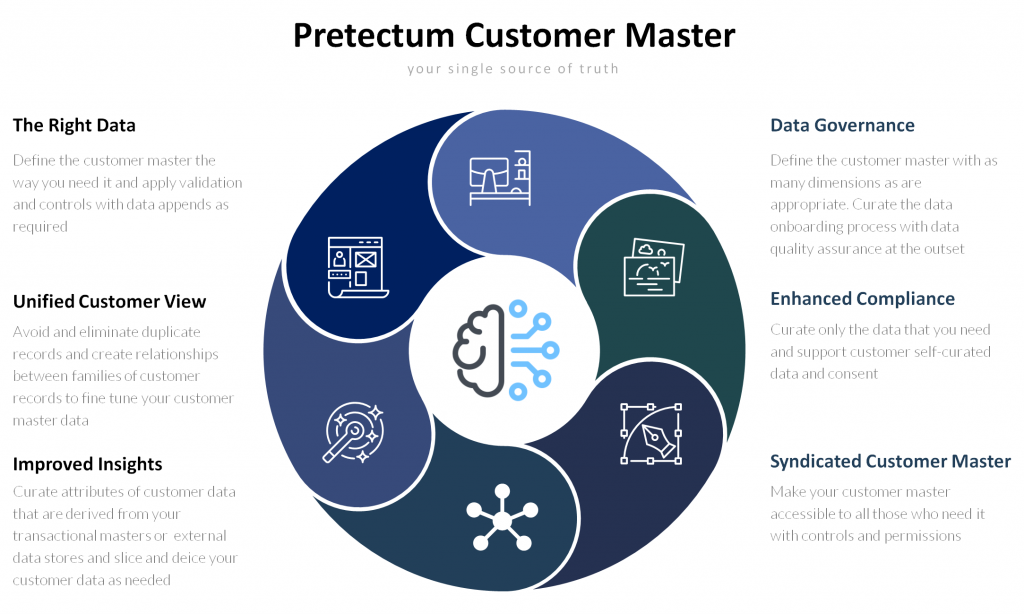OCRUM (Objective-Centric Risk and Uncertainty Management) is a structured framework designed to help organizations manage risks and uncertainties in a way that aligns with their specific objectives and goals.
Unlike traditional risk management approaches, which often focus on identifying and mitigating risks in isolation, OCRUM emphasizes a goal-oriented approach. It integrates risk management with decision-making processes to ensure that risks are managed in the context of achieving organizational objectives.
OCRUM could be considered a valuable framework in the context of your Customer MDM because it provides a structured, objective-driven approach to managing risks and uncertainties in customer data.
By aligning data management with business goals, quantifying uncertainties, and enabling proactive decision-making, OCRUM ensures that customer data remains a valuable and reliable asset.
This would not only enhance data quality and compliance but also support better customer experiences, improved decision-making, and overall business success.
Aligning Data Management with Business Objectives
Aligning data management with business objectives is a strategic approach that ensures data initiatives directly support and enhance a company’s goals and priorities. By aligning these two critical components, organizations can maximize the value derived from their data assets, enabling more informed decision-making and driving competitive advantage. This alignment involves clearly understanding business goals, such as improving customer experiences, optimizing operations, or driving innovation, and then tailoring data management practices to support these aims.
It requires collaboration across departments, fostering a culture where data is seen as a strategic asset, and implementing robust data governance frameworks to ensure data quality, security, and compliance. Ultimately, this alignment helps organizations to not only achieve their business objectives more efficiently but also to remain agile and responsive in a rapidly evolving market landscape.
Customer data is not just a technical asset—it can also be considered a strategic resource that drives decision-making, customer engagement, and business growth. Under the OCRUM framework, this would ensure that CMDM efforts are aligned with organizational goals, such as improving customer experience, increasing sales and revenue, enhancing compliance and reducing regulatory risks and supporting various data-driven strategies.
By focusing on objectives, OCRUM helps to ensure that data management initiatives deliver measurable business value rather than just addressing technical or operational concerns which may often dominate the focus of attention.

Identifying and Mitigating Risks in Customer Data
Identifying and mitigating risks in customer data is a critical component of modern business operations, ensuring both regulatory compliance and the protection of consumer privacy. In an age where data breaches and cyber threats are increasingly common, organizations must proactively assess potential vulnerabilities in their data management systems. This involves conducting thorough risk assessments to identify areas where data might be exposed to unauthorized access, loss, or misuse.
Once risks are identified, businesses can implement robust security measures such as encryption, access controls, and regular audits to safeguard customer information. Additionally, fostering a culture of data privacy awareness among employees through regular training can help mitigate human error, which is often a significant risk factor. By prioritizing the protection of customer data, companies not only build trust with their clients but also maintain compliance with stringent data protection regulations such as GDPR and CCPA, ultimately securing their reputation and long-term success.
Customer data is prone to various risks, amongst them, DQ issues, such as inaccurate, incomplete, or outdated data can lead to poor decision-making and customer dissatisfaction; non-compliance risks associated with data protection regulations (e.g., GDPR), that can result in legal penalties and reputational damage. Security Risks like data breaches or unauthorized access can compromise customer trust and lead to financial losses.
OCRUM provides a structured approach to identifying, assessing, and mitigating these risks, helping ensure that customer data remains accurate, secure, and compliant.

Quantifying uncertainty in Customer Data
Uncertainties in customer data, such as missing information, unreliable sources, or inconsistent updates, can undermine the data’s usefulness. OCRUM emphasizes quantifying these uncertainties, enabling organizations to measure the reliability of customer data, prioritize data quality improvements and make informed decisions based on trustworthy data.
Quantifying uncertainty in customer data is a critical process in modern data analytics, as it provides businesses with a clearer understanding of the limitations and reliability of the data they rely on for decision-making.
This process involves identifying and measuring sources of variability and inaccuracy in data, such as sampling errors, data entry mistakes, and model assumptions. By applying statistical techniques and probabilistic models, organizations can assess the degree of confidence in their customer insights, allowing them to make more informed decisions. Understanding uncertainty also helps in risk management, as it enables companies to prepare for potential deviations from expected outcomes and to implement strategies that accommodate varying scenarios. Ultimately, managing uncertainty in customer data not only improves the precision of business strategies but also enhances customer satisfaction by tailoring services to more accurately meet consumer needs.
This is especially important in CMDM, where high-quality data is essential for activities like transaction processing, fraud avoidance, customer segmentation, personalized marketing, and predictive analytics.

Support for proactive Decision-Making
Modern organizations must make swift, data-driven decisions to stay competitive.
OCRUM facilitates proactive decision-making by offering a clear understanding of risks and uncertainties in customer data, identifying areas for data quality enhancement, and providing insights into how this data impacts business objectives.
It plays a vital role in helping businesses navigate the complexities of customer data, empowering them to address critical data quality issues and align strategies with data-driven realities. By transforming potential data challenges into opportunities for growth and innovation, OCRUM fosters a culture of informed decision-making that drives success.
For instance, if a company discovers that a large portion of its customer data is outdated, OCRUM helps prioritize efforts to update the data, ensuring that marketing campaigns and customer interactions are based on accurate information.

Enhancing the Customer Experience
High-quality customer data is essential for creating a positive customer experience, as it enables organizations to understand and meet their customers’ needs effectively.
OCRUM, a comprehensive framework, assists organizations in maintaining accurate and up-to-date customer records, which serve as the bedrock for all customer-related operations. Under the guidance of the OCRUM framework, organizations can enhance their ability to personalize interactions with their customers. By relying on reliable and precise data, businesses can tailor their communications and offers to match individual customer preferences and behaviors, leading to more engaging and meaningful interactions.
OCRUM facilitates the swift resolution of customer issues by providing a single, unified view of customer information. This consolidated view ensures that all necessary data is at the fingertips of customer service representatives, allowing them to address and resolve inquiries or problems quickly and efficiently. By minimizing uncertainties and risks associated with customer data, OCRUM plays a critical role in ensuring the integrity and reliability of customer information.
This reliability is crucial for organizations aiming to deliver consistent, personalized, and satisfying experiences to their customers. In turn, these positive experiences can lead to increased customer loyalty, enhanced brand reputation, and ultimately, a stronger competitive edge in the market. In summary, OCRUM not only supports organizations in managing their customer data effectively but also empowers them to leverage this data to foster deeper customer relationships and drive business success.
The positive experiences facilitated by OCRUM can significantly contribute to a competitive edge in the market. Satisfied customers are more likely to remain loyal, recommend the brand to others, and contribute to a positive brand image. This, in turn, can lead to increased market share and business growth.
Ultimately, OCRUM not only supports organizations in managing their customer data effectively but also empowers them to leverage this data to foster deeper customer relationships. By doing so, businesses can drive success, enhance their competitive position, and ultimately achieve long-term growth in the face of often stiff, competition.

Improving Compliance and Reducing Regulatory Risks
Increasing regulatory scrutiny around data privacy and protection, organizations must ensure that their customer data management practices comply with the growing number of local, regional, national and international laws. OCRUM helps by identifying compliance gaps in customer data; quantifying the risks of non-compliance and suggesting the implementation of measures to ensure data is handled in accordance with regulations
This reduces the likelihood of legal penalties and reputational damage.

Continuous Improvement
Customer data is dynamic, and risks and uncertainties can evolve over time. OCRUM’s emphasis on continuous monitoring and improvement ensures that organizations stay ahead of emerging risks (e.g., new data privacy regulations or cybersecurity threats); adapt their CMDM strategies to changing business needs and continuously refine data quality and risk management practices
This iterative approach ensures that customer data remains a reliable asset for the organization.
Integration with Broader Risk Management
CMDM cannot operate in isolation—it must be considered as a part of a broader ecosystem of business processes and risk-bound systems. OCRUM facilitates integration between CMDM and other risk management frameworks, enabling more holistic views of customer-related risks across the organization. In addition, better coordination between data management and risk management teams becomes easier and is accompanied by enhanced reporting and analytics potential for risk-informed decision-making.
To learn more about how Pretectum CMDM can help with your risk management program, contact us today.


